
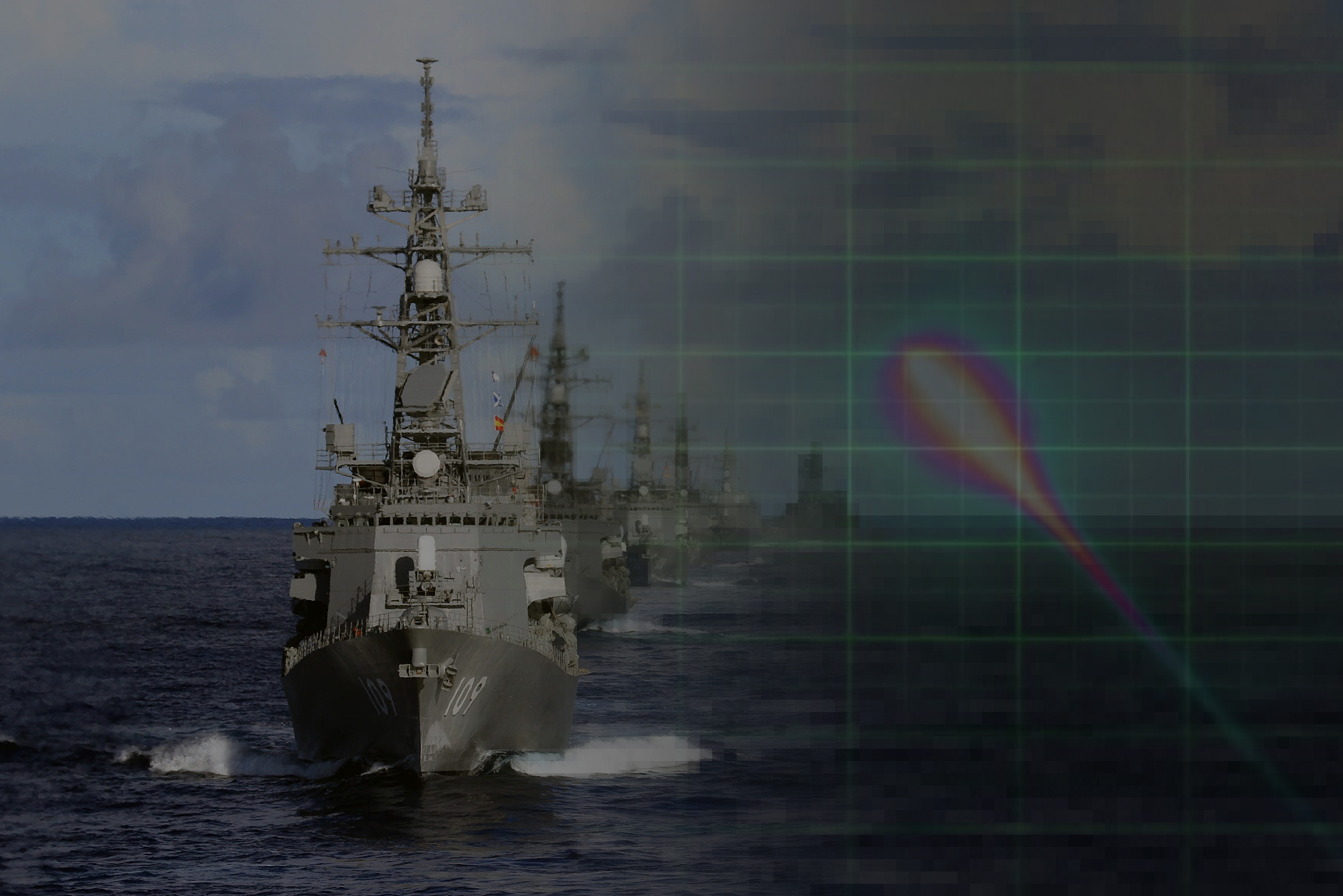

An Aegis-capable guided-missile destroyer USS Pinckney (DDG 91) and Japan Maritime Self-Defense Force ships in waters near Guam in 2014. / U.S. Navy photo by Cryptologic Technician Collection 3rd Class Raul Sanchez // Illustration by Ben Watson
The U.S. military has four primary means of shooting down incoming missiles. But even together, they can’t promise to stop everything.
The skies were calm over Oahu, Hawaii, one terrifying Saturday morning this past January.
There on the beach you would have seen a child dancing and playing in the sand — unaware of what more than a million people believed was soon reentering the Earth’s atmosphere headed for them.
"When you read the words ‘ballistic missile,’ you know that if something is coming our way, it is nuclear. It doesn’t matter if it hits you,” the child’s mother typed into her phone as the last of a high tide washed out to sea.
“On an island the size of Oahu, there is nowhere to go,” she continued to her friends on Facebook. “No way of outrunning it. Even if you can escape the blast, you can expect the winds to cover the island with radiation. And with nowhere to land planes, how long will aid take? How long will it take to get food and water and medical supplies 2,500 miles to an island in the middle of the Pacific? How do you find shelter?”
Whether it’s U.S. islands like Guam or Hawaii, coastal cities like San Diego or New York City, or allied territories oceans away, the 21st century has heightened the threat of ballistic missiles to the United States and its allies. Some examples:
- Iran has been threatening Israel (and U.S. Navy vessels) with its missile program for decades.
- Chinese technology is advancing rapidly — possibly bypassing U.S. missile technology as soon as 2020.
- And of course, advances in North Korea’s ballistic and nuclear weapons programs have raised the stakes dramatically in just the past two years alone.
But what could Hawaii — or the U.S. military — have done that January morning, had the missile been real?
Weapons analysts talk about the path of a ballistic missile in three phases:
- Boost: The missile’s most vulnerable few minutes, from ignition through launch to engine shutoff at the edge of the atmosphere.
- Midcourse: The missile is now on its course, with the midpoint its apogee in space, and the latter half a descent arcing to its target with greater speed (as long as 20 minutes for ICBMs);
- Terminal: The final minute or so, when the warhead or warheads re-enter the atmosphere.
The U.S. military has four systems to shoot down ballistic missiles, most focusing on the second and third phases. It’s an expensive approach, to be sure; and in 17 years of tests, the four systems have hit their targets about four out of of every five tries. But military planners know that when the missiles actually fly, a single missed intercept could have unspeakably catastrophic consequences.
And so the entire system is getting more expensive.

America’s ballistic missile defense network has cost U.S. taxpayers $132 billion since 2002. This fiscal year, the Missile Defense Agency, which commands America’s ballistic missile defense network, is looking at the rising threats from North Korea, China, and Iran, and requesting almost $13 billion to update those systems. That’s 27 percent more than it asked for in its previous budget — back before North Korea’s first successfully ICBM test on July 4, 2017.
Had that Hawaii-bound missile been real, the launch would have triggered dozens of monitors linked to America’s four anti-missile systems, including a satellite array orbiting the globe, beaming down realtime data on speed and trajectory.
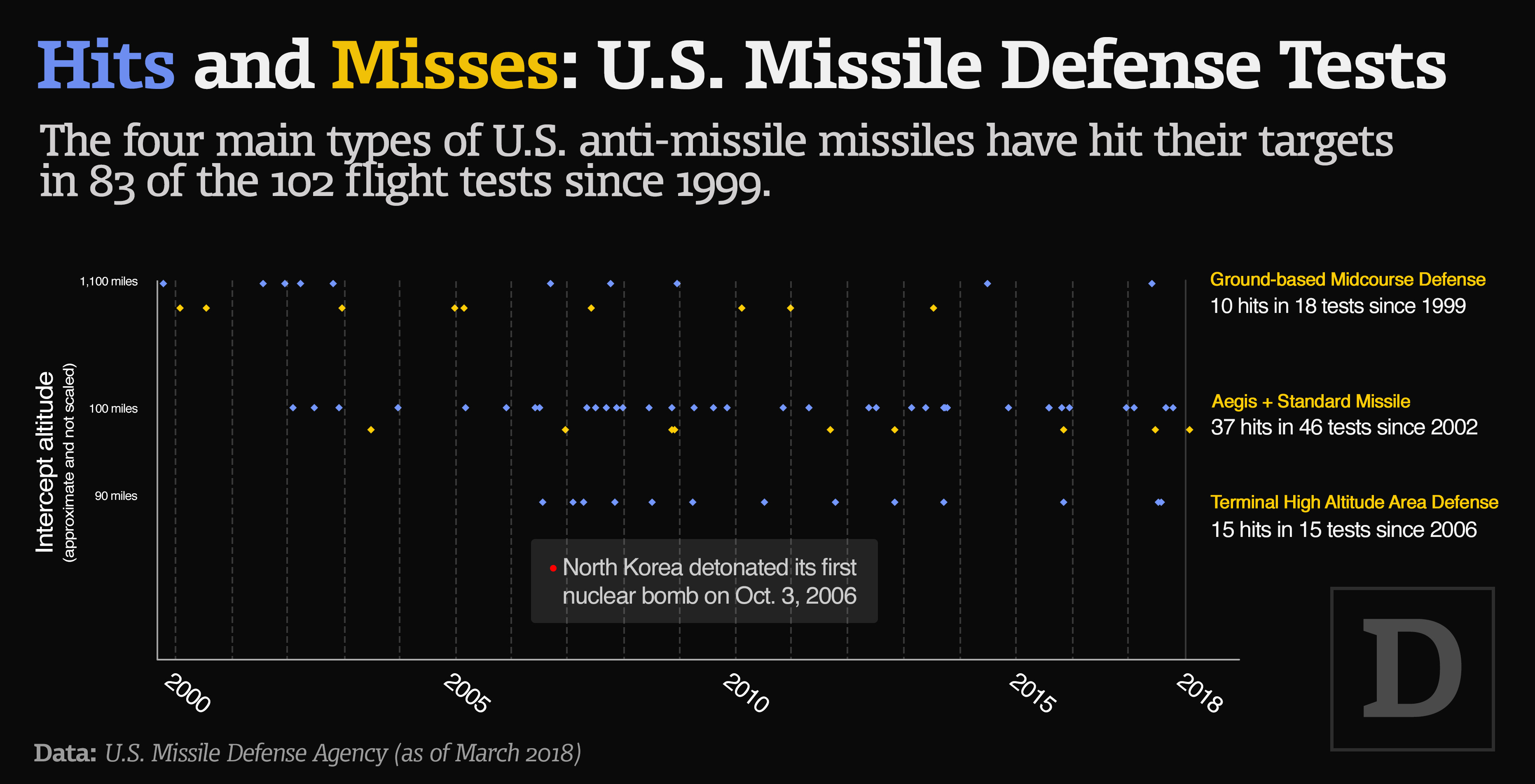
But with an 81 percent success rate across all of the systems combined, the truth is we simply don’t know if this multi-billion dollar network would have worked. The thousands of military personnel in front of monitoring systems from Japan to the UK would presumably know this very well.
"I am absolutely confident the missile defense system will work."U.S. Defense Secretary James Mattis, June 25, 2018
For the rest of us, here is a review of what systems those troops would likely have turned to while that ICBM ripped across the upper atmosphere at a speed of nearly six to seven kilometers per second. A rate that fast would give personnel down in Hawaii about 20 minutes to launch something in the air in the hopes of an intercept. Here are some of their options, and when they would be most useful for stopping an incoming nuclear missile.

Forget about it. This phase is called “the holy grail” of ballistic missile defense for a reason: To shoot down a missile immediately after takeoff requires an enormous commitment of troops and systems. And each of those systems would have needed to be “on station,” as it were, training their eyes on the known launch territory well in advance.
Nations like North Korea, to say nothing of China or even Russia, can launch ICBMs from mobile launchers — which can be almost impossible to track with aerial surveillance. The best shot for something like a boost-phase intercept hinges on the Aegis Ballistic Missile Defense system combining multiple radars (AN/SPY-1, e.g.) with a range of Raytheon-made missiles.

The U.S. Navy’s Aegis system began 35 years ago as a radar array for surveillance and tracking ballistic missiles, then took on a new capability in 2005, when it was reconfigured to provide targeting data to anti-missile interceptors. That mobile, networked combination lets the U.S. put a missile-defense system wherever it can get any one of the Navy’s 31 Aegis-equipped destroyers and 5 cruisers.
The U.S. Navy says it wants 40 of these ships "capable of both knocking down an incoming ballistic missile while simultaneously looking for and firing upon an incoming cruise missile that’s at the surface of the ocean," according to Rear Adm. Peter Fanta, Deputy Chief of Naval Operations, Director, Surface Warfare Division, speaking to lawmakers in 2015.
Of America’s 33 deployed Aegis missile-defense ships today, 17 work under the Pacific Fleet and 16 in the Atlantic. Japan also has Aegis-capable destroyers (four); other U.S. allies with or working toward acquiring Aegis-capable vessels include South Korea, Australia, Norway and Spain. And Spain could acquire nearly a half-dozen new Aegis missile defense systems relatively soon. This week, the State Department approved the sale of five new Aegis weapons systems to the country at a cost of $860 million. The decision now moves to Congress, where little opposition is expected.
The U.S. Navy temporarily lost two Aegis-enabled destroyers — the Fitzgerald (DDG-62) and the John S McCain (DDG-56) — to collisions at sea in 2017.
One single Aegis system can track up to 100 targets simultaneously. And that could come in handy because the system was not designed for ICBMs — only up to ICBM-size (that is, intermediate-range ballistic missiles), and during the early ascent window of the midcourse phase. This time period could span the first five to 10 minutes (less likely), or work furiously in the final 10 to 15 (more likely).
The Aegis system hasn’t best tested for boost intercepts. Rather, the tests conducted so far have focused on intercepts closer to the terminal phase, when comparatively more data — largely infrared — would have been processed by the entire ballistic missile defense sensor network across the globe (more on that here).
Lucky for Hawaii, the Aegis system has been tested most at the Pacific Missile Range Facility in Kauai. The good news: in tests, Aegis has guided Raytheon Standard Missiles to successful intercepts 37 out of 46 times. The bad news: Aegis failed its most recent test in January 2018.
But in more recent welcome news for islanders, the MDA is pushing to install two billion-dollar missile defense radars on Oahu’s north shore. The new radars would be similar to the Cobra Dane system already in place on the far western island reaches of Alaska, at Eareckson Air Station.
Questions for the future of the Aegis program:
When can the Navy add ship-based lasers, electromagnetic railguns (EMRGs), and hypervelocity projectiles (HVPs) to its Aegis arsenal?
This year, the MDA wants more than $820 million for general equipment purchases, upgrades and testing, and another $15 million to begin building a new Aegis “ashore” site in Poland (think Iran and Russia). Already one Aegis “Aegis ashore” site is up and running in Romania
However, using the Aegis system for a terminal interception closer to Hawaii assumes our second missile-defense approach — the Ground-based Midcourse Defense system — has not already intercepted the target. The sad news is that dismal scenario is fairly plausible.
Citizens on the U.S. mainland have at least 44 anti-missile missiles that might hit an incoming ICBM during its midcourse phase, each in its own silo in two West Coast locations:
- Vandenberg Air Force Base, Calif., about a three-hour drive up Highway 101 from Los Angeles.
- Fort Greely, Alaska, about two hours south of Fairbanks.
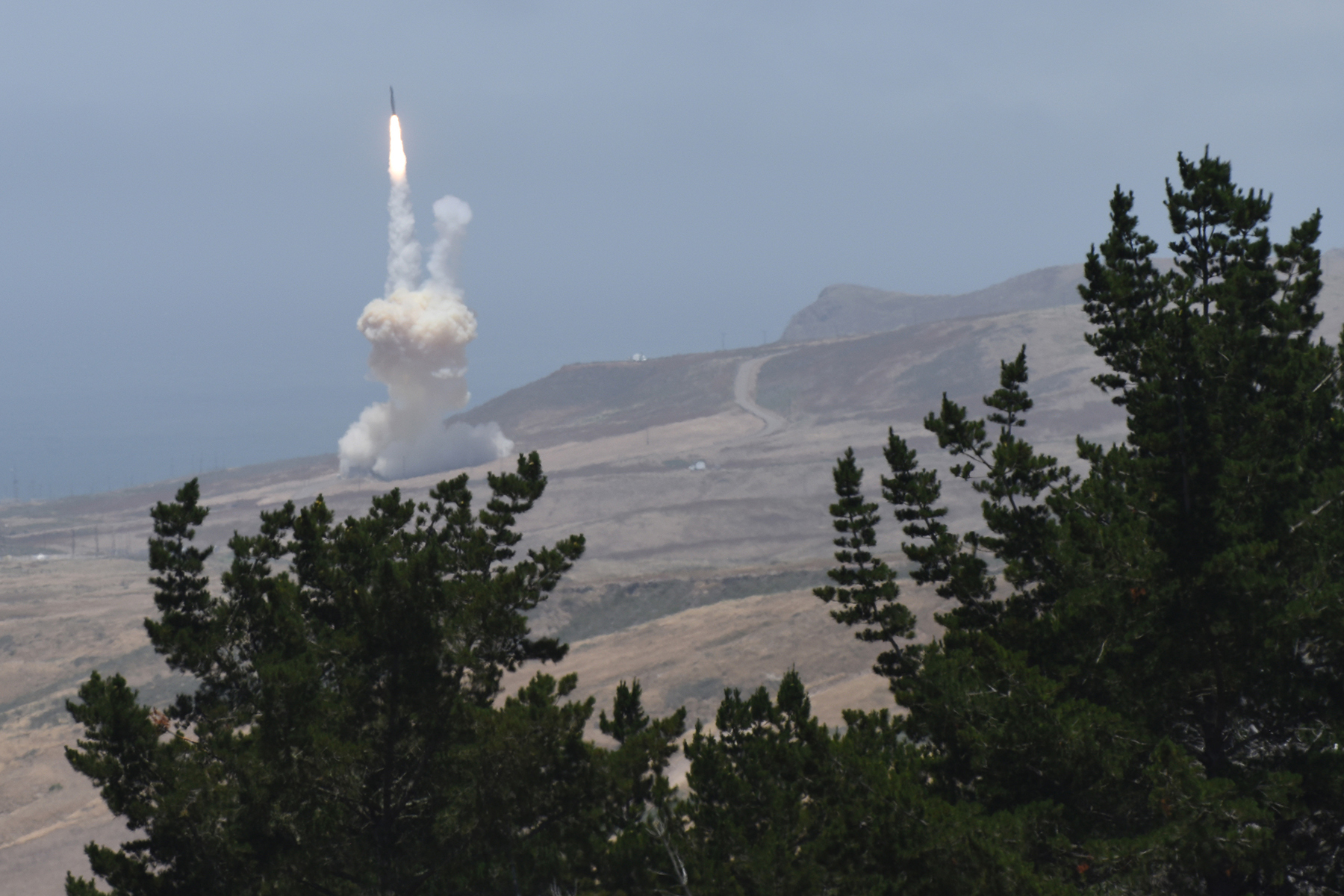
An ICBM intercept test of the Ground-based Midcourse Defense (GMD) system at Vandenberg Air Force Base, Calif., May 2017. Photo by Senior Airman Robert Volio
Greely is home to 40 three-stage anti-missile missiles designed to hit a bullet with another bullet. One thing that could raise the intercept success rate: Lots more bullets. This year, the Missile Defense Agency is asking Congress for more than half a billion dollars ($524 million) to add another 20 silos to the facilities at Greely. The final work, however, wont be done until 2023.
Greely occupies prime real estate in the spaces between the U.S. mainland and both Russia and North Korea. Vandenberg, on the other hand, will have to do with its four silos (real estate in Alaska is a bit better located for this job — and, of course, considerably cheaper than the California coast).
That adds up to 44 GBMD missiles today for a system whose success rate is, by comparison, the worst of them all — 56 percent, or 10 out of 18 tests since 1999.
What’s more, the GBMD system has not been tested on decoys, or more than one target at the same time.
To review: Intercept in boost phase? Forget about it. And midcourse phase? At least four in 10 missiles will likely slip through the GBMD system. You might get an Aegis system in the right place at the right time — but that’s a stretch, especially when U.S. Navy ships are colliding because the sea lanes are too crowded.
That leaves one final window to act.

This is the area with the greatest number of options for the U.S. and the 16 other nations who share technology for shooting down ballistic missiles. It’s perhaps understandable there are so many options: trajectory data would be in greater supply, for one thing. And quite crucially in this phase, you don’t have to always hit a bullet with a bullet.
The most globally widespread “terminal” shoot-down system is the U.S.-made PATRIOT Advanced Capability-3 (or, PAC-3). Of the 1,280 operational PAC-3s around the world, the U.S. military owns about 1,100. The rest are distributed across militaries from Bahrain, Egypt, Germany, Greece, Israel, Japan, Jordan, Kuwait, the Netherlands, Saudi Arabia, South Korea, Spain, Taiwan, and the UAE.
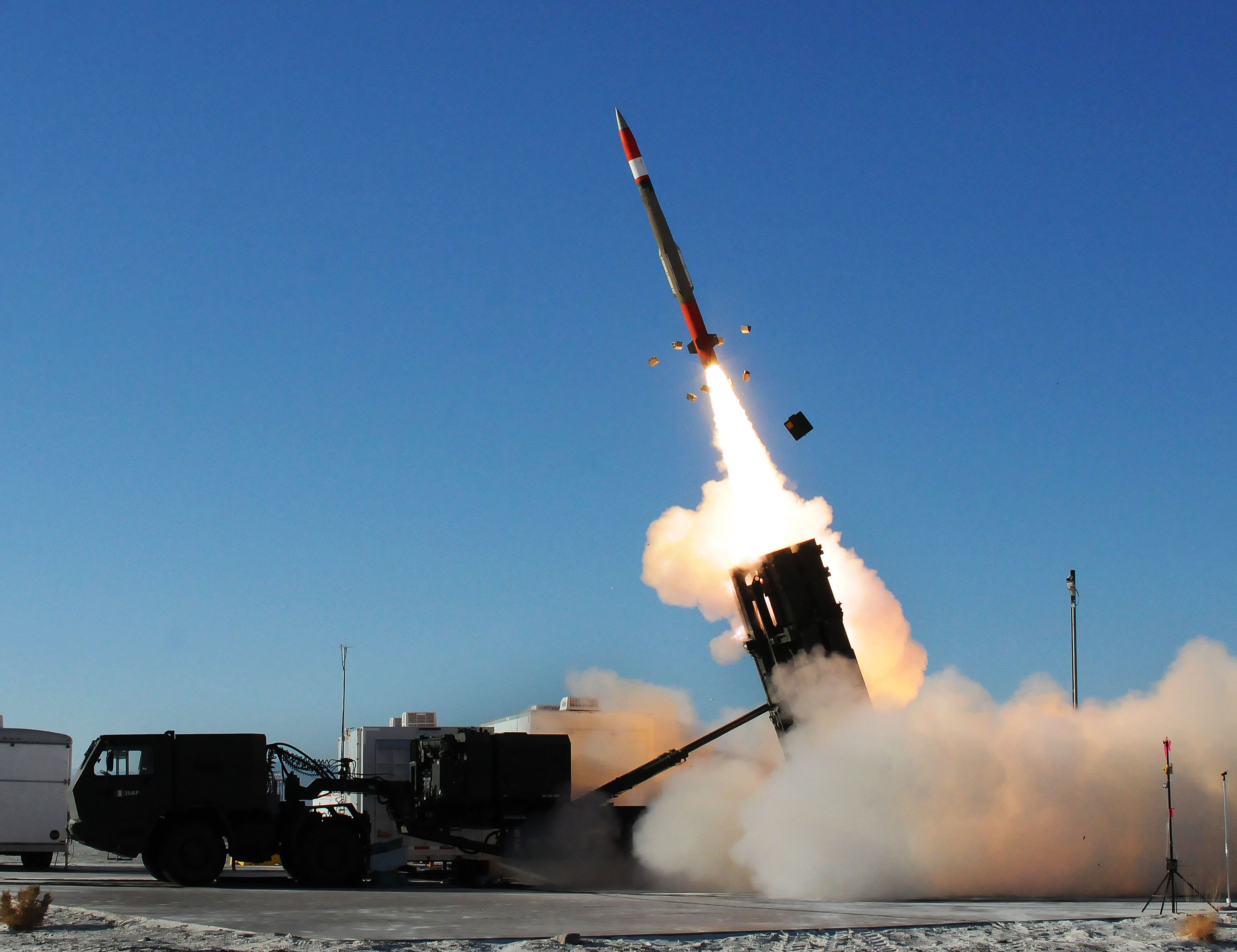
A PAC-3 Medium Extended Air Defense System missile is launched to intercept a target at White Sands Missile Range on Nov. 29, 2012. Photo by John Hamilton
Each PAC-3 battery carries 16 missiles. But bad news for our Hawaii scenario: Each was designed primarily for short- and medium-range ballistic missiles. And that would be a huge problem against a fast-moving ICBM. The only upside is the PAC-3’s exploding warhead — called a blast fragmentation warhead — which could alter an ICBM’s course or perhaps even provoke an early detonation.
And the final system available for knocking missiles out of the sky today: the truck-mounted Terminal High Altitude Area Defense system. THAAD packs a series of punches: each truck carries eight interceptors; an entire THAAD battery can include up to 72. These systems unite the data from ground-based AN/TPY-2 radar units with infrared sensing to destroy its target at either the end of midcourse flight, or — as its name suggests, in the final phase.
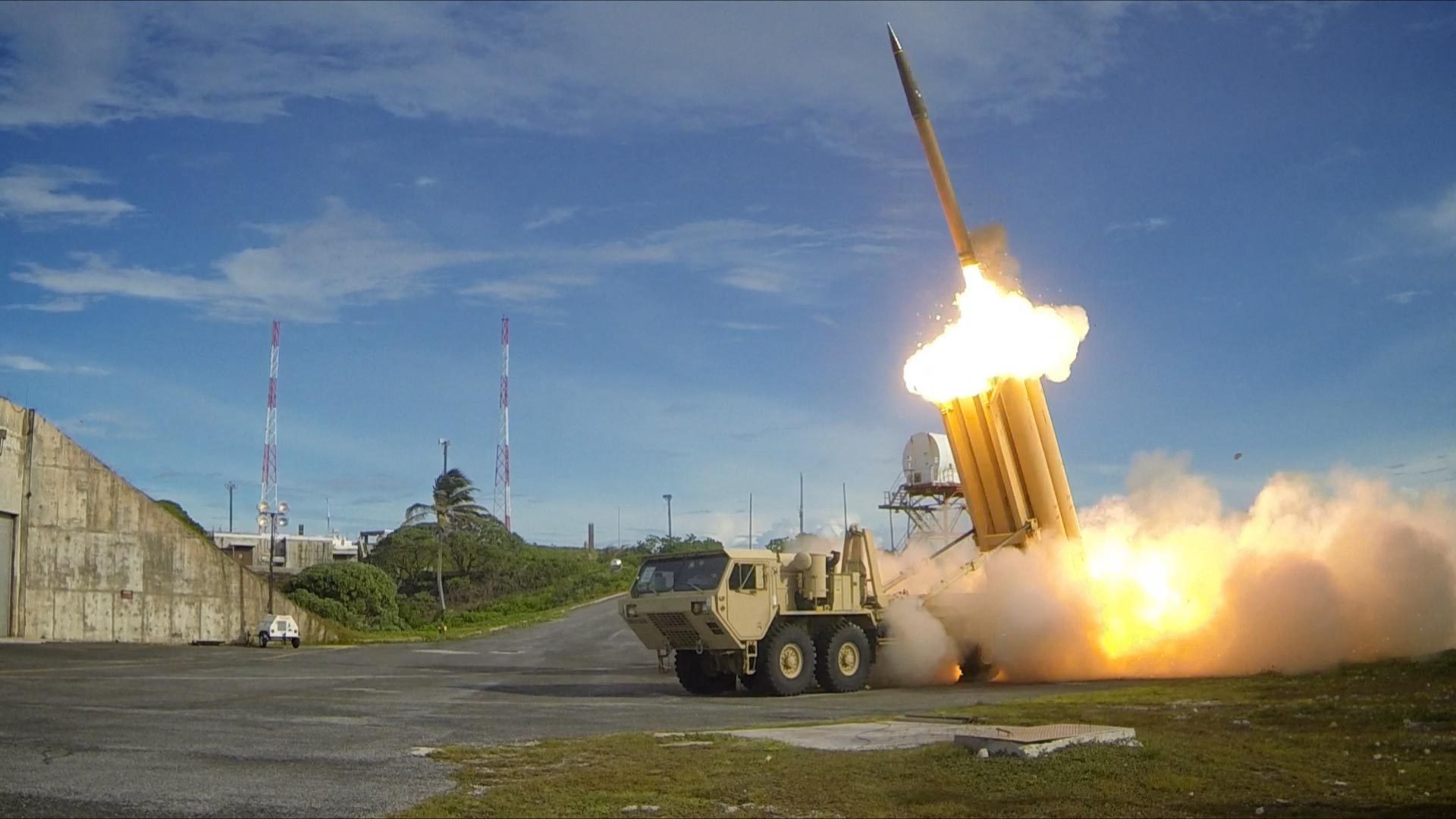
The first of two Terminal High Altitude Area Defense (THAAD) interceptors is launched during a successful intercept test, Sept. 10, 2013. Photo by Missile Defense Agency
THAAD has both the best and least-tested record of the four systems. Since testing began in 2006, THAAD missiles have hit their target 15 out of 15 times. Its latest test — in July 2017 — proved successful against its toughest target yet: an intermediate-range ballistic missile.
The U.S. has six THAAD batteries, including three in the Pacific region. Fortunately for the families in our Hawaii scenario, the Aloha state is one of them. Guam (since 2013) and South Korea (since 2017) are the other two in the vicinity of North Korea.
The MDA wants nearly $1 billion in the year ahead to keep its THAAD units ready, including $874.1 million for “interceptor procurement, obsolescence mitigation and equipment.” But there are many more elements of the U.S. ballistic missile defense system that want their part of the 27 percent increase in MDA’s 2019 budget request. Also included:
- Parts and components for an infrared Space-based Kill Assessment experiment;
- Another $220.9 million to develop “advanced discrimination algorithms” for the BMD sensor array;
- $37 million to maintain satellites in space;
- $61 million for THAAD testing;
- $96 million for Aegis testing;
- $160 million for three new radars, including two just for the Pacific region;
- And lots more.
Which is all to say: 81 percent protection from a single ballistic missile costs nearly $10 billion in 2018. And it could be nearly $13 billion in the year ahead. The alternative is essentially “duck and cover.”
We may be past the start of the nuclear age, but we have not moved beyond the shadow of its menacing cloud. Very few areas of national security have more at stake — potentially thousands upon thousands of human lives — than missile defense in the 21st century.
One other brutal reality: There are more than 14,000 nuclear weapons through the world today: 13,300 of those in the hands of the U.S. (6,450) and Russia (6,850), according to the latest 2018 arms control figures from SIPRI. China has 280 and Pakistan about half that. The biggest wild card, North Korea, is believed to have between 10 and 20. Just one of those poking through U.S. missile defenses would be unspeakably catastrophic.
How almost all of this could become instantly obsolete: Chinese or U.S. advances in hypersonic missile (and hypersonic interception) technology. But that future, at least for now, appears to be a long way off. 

